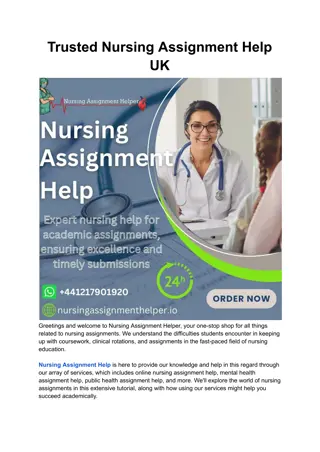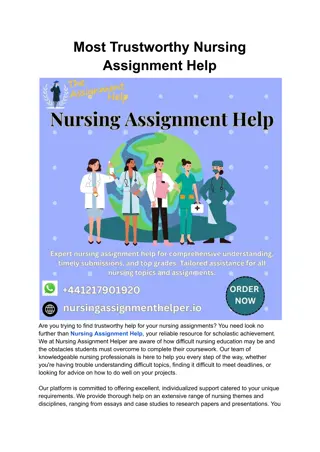Evolution of Nursing Through History
Explore the rich historical journey of nursing, from its origins in classical times to the modern era. Discover how nursing has evolved, reflecting social and political contexts. Learn about key figures like Florence Nightingale and the roles of nurses in promoting health, preventing disease, and advocating for those in need.
Download Presentation

Please find below an Image/Link to download the presentation.
The content on the website is provided AS IS for your information and personal use only. It may not be sold, licensed, or shared on other websites without obtaining consent from the author.If you encounter any issues during the download, it is possible that the publisher has removed the file from their server.
You are allowed to download the files provided on this website for personal or commercial use, subject to the condition that they are used lawfully. All files are the property of their respective owners.
The content on the website is provided AS IS for your information and personal use only. It may not be sold, licensed, or shared on other websites without obtaining consent from the author.
E N D
Presentation Transcript
History and Social Context Catherine Hrycyk, MScN, RN
History and Social Context Work in pairs. Answer the following questions (write them down): 1. Where do nurses work? 2. What is the public image of nursing? 3. Whom do nurses report to? 2
Evolution of Definitions of Nursing Reflect the social and political context of the time Florence Nightingale Notes on Nursing: What It Is and What It Is Not (originally published 1859) Early 20th century definitions:Harmer and Henderson (1939) Professional associations definitions ANA ICN Five common themes in all definitions of nursing. Nurses: 1. Promote health 2. Prevent disease 3. Restore health 4. Alleviate suffering 5. Advocacy for those in need 3
History of Nursing: Classical Times Need to care for ill, infirm, children and elders as old as human society Ancient Greece: Special protected sites for the provision of care Ancient Rome: Rudimentary regulation of activities that constitute nursing in Lex Duodecem Tabularum (509 BC) Primary goal to protect recipients of care Religious orders dedicated to the provision of care 4
History of Nursing: Medieval Times Religious orders Military units Knight Templars: Often labeled first professional nurses Men only Had insignia that identified them as nurses and protected them while tending to wounded soldiers Nursing pin derived from the insignia 5
19th Century: Reform of Nursing Florence Nightingale Reformed nursing practice and education Training: Kaiserswerth, Germany and Sisters of Charity, Paris Crimean War (1854 1956) hospital set-up in Scutari, Turkey used scientific methods to evaluate morbidity and mortality Introduced scientific methodology to nursing, first RECORDED nurse scientist Data collection on morbidity and mortality to reform the British healthcare 1859: Notes on Nursing 1860: Founded first modernschool for nurses (St. Thomas Hospital, London) 6
Historic Events Affecting Nursing in USA The American Civil War: The war created an impetus for nursing training No available professional nurses at the start of the war. It helped advance professional nursing practice Nursing leaders though achieved dramatic improvements in care The success in the reform of military hospitals served as a model for reform of civilian hospitals nationwide. After the Civil War: 1861: Sanitary Commission relief agency to support wounded and sick soldiers schools for nurses in large hospitals Multiple schools based on Nightingale s model American Red Cross Clara Barton nurse leader, founder of American Red Cross 7
The Henry Street Settlement Early in 20th Century Influx of immigrants and factory work in northeastern US Infections and overcrowding in inner city tenements 1893: Establishment of Henry Street Settlement Lillian Wald and Lavinia Dock They sought finances and formalized public health. They treated minor illnesses, prevented disease transmission, and provided health education. Margaret Sanger and Lower East Side (Kennedy, 1970) Immigrant women Safe contraception and family planning 8
Nursing Licensure Licensure began in New Zealand, followed by British Columbia (Canada), UK and NC (USA) Ellen Dougherty first registered nurse (NZ) ICN resolution: Each country and state to provide for licensure of the nurses 1903: Permissive licensure laws: Nurses did not have to be registered to practice but could not use the title of registered nurse (RN) unless registered. 1923: All states required permissive licensure 1947: New York fully mandated licensure 1950: NLN and first nationwide State Board Test Pool Examination 9
Historic Events in 20th/21st Centuries Vietnam war Events influencing nursing: World war 1 Human rights movement Flu pandemic New pandemics (HIV/AIDS) TB pandemic Climate change and natural disasters World war 2 Changing role of women Terrorism 10
Nursing in USA Today The Nursing Workforce Surveys : National Sample Survey of Registered Nurses (Health Resources and Services Administration [HRSA], 2013) A comprehensive survey of nursing workforce every 4 years since 1977 Final 2008 report: http://bhpr.hrsa.gov/healthworkforce/rnsurveys/rnsurveyfinal.pdf. 2013: Comprehensive national survey of RNs (Budden, Zhong, & Moulton, 2013) National Council of State Boards of Nursing (NCSBN) and the Forum of State Nursing Workforce Centers (FSNWC) 11
Social Context: Image of Nursing Media depiction of nurses Nursing caps and other forms of identification Gallup surveys: Nurses were rated No 1 among a number of professions and occupations on honesty and ethics every year since 1994 (except 2001, #2) Woodhull Study on Nursing and the Media (1997): Nurses and the nursing profession are essentially invisible to the media and, consequently, to the American public 12
Nurses in the Workforce 2000s RN grew by 24.1% (Health Resources and Services Administration, 2013). 2013 More than 4 million held licenses as RNs (Budden et al., 2013). ~2.8 million nurses were working (HRSA, 2013). 2008 NSSRN data 90% of < 50 years old were employed in nursing full- or part-time. A significant percentage of nurses held two nursing positions. 13
Nurses in the Workforce: Gender Dominated by women 2000 2008: Men in nursing increased by 50% (US DHHS, 2010) Among NCSBN/FSNWC survey Before 2000: 5% men 2010 and 2013: 11% men (Budden et al., 2013) 14
Nurses in the Workforce: Age Average age of RN in US is over 50: Why? Recent economic downturn and high unemployment rates Older nurses are more likely to remain in the workforce because the nursing field is reasonably protected from the layoffs and downsizing experienced in other professions. RNs < 40 year old were 25.9% of total RN workforce in 2008 15
Nurses in the Workforce: Race and Ethnicity Racial and ethnic minorities 37% of Americans. Only 19% of the RN population are minorities (Budden et al., 2013). Hispanics/Latinos: 15.4% of the U.S. vs. 3.6% of RNs Black/African American: 12.2% of the U.S. vs. 5.4% of RNs. Asian or Native Hawaiian/Pacific Islander: 4.5% of the US vs. 5.8% of RNs 16
Nurses in the Workforce: Education Entry level into Practice Successful completion of pre-licensure education Successful passing the NCLEX-RN. Successfully passing the NCLEX-RN then qualifies you to be licensed as an RN. Multiple educational pathways to qualify to take the NCLEX (1) Bachelor of Science in Nursing (BSN) degree, (2) Graduate programs (MSN, DNP), (3) Associate of Science in Nursing (ADN), (4) Diploma programs. The number of BSN and graduate prepared nursing steadily increasing 17
Nurses in the Workforce: Foreign Educated Increasing recruitment internationally educated nurses (3.7% in 2004 to 5.6% in 2008(Thekdi, Wilson, and Xu, 2011): Strategy to expand the nursing workforce in response to the recent nursing shortages. Importing nurses from countries with comparable/equivalent education Issues facing the foreign-educated nurses: Different views of gender, authority, power, and age (Thekdi at al., 2011) . Absolute respect for experts and teachers among foreign tranined nurse creates permanent barrier between nurse-managers and foreign- educated nurses. 18
Four Most Common Roles 1. Direct patient care 2. Administrative roles 3. Research and education 4. Advanced practice 19
Practice Settings for Professional Nurses Acute care settings (e.g. hospitals) 63.2% Ambulatory care 10.5% Public and community health 7.8% Home health 6.4% Extended care facilities 5.3% Others ~6.8% (US DHHS, 2010, 3 9) 20
Nursing in Hospitals Educational credentials: ADN, BSN, MSN, DNP, PhD Entry-level positions require RN licensure: BSN may be preferred or required As per research, outcomes better in hospitals with higher proportion of RN s holding BSN Nurse managers - 24-hour accountability, required to have MSN or higher Clinical nurse specialists advance practice role Example: Oncology clinical specialist Strong focus on evidence-based practice (EBP) 21
Nursing in Communities Community nursing: Lillian Wald (1867 1940) and the Henry Street Settlement in New York City in 1895 Lillian Wald considered the founder for community / public health nursing Broad field of community health nursing Focus on prevention and community education Homecare: Emerging specialty distinct from community nursing Increasing utilization of home based nursing services Homecare associated with improved outcomes and is more cost-effective American Nurses Credentialing Center (ANCC) 22
Nursing in Schools National Association of School Nurses (NASN) (2015): School nursing is a specialized practice of professional nursing that advances the well-being, academic success, life- long achievement, and health of students. Impact of school nursing Requirements including knowledge and skills Counselling, health curriculum, routine illness, and emergencies Specific issues: Abuse, school violence, and obesity 23
Other Settings Outpatient settings (clinics) Telehealth Nursing informatics Occupational health Nursing in faith communities Armed forces: Scope of practice different / generally wider Entrepreneurship Nursing education Palliative care and end-of- life settings 24
Clinical Nurse Leaders AACN (2008): Clinical nurse leader as a new credential Intent: allow master s-prepared nurses to oversee and manage care at the point of care in various settings Not intended to be administrators or managers, but are clinical experts 25
Advanced Practice Nursing Advanced educational and clinical practice requirements beyond basic pre-licensure nursing education. 2008: More than a quarter of a million RNs held the required credentials to work as advanced practice nurses (APNs) (US DHHS, 2010). High patient acceptance and cost-effective Graduate education: Minimum MSN with post-MSN certificate DNP - required after 2018) 26
Advanced Practice Nursing 1. Nurse Practitioner (NP): Diagnose and treat acute and chronic conditions 2. Clinical Nurse Specialists (CNS) Initially developed in mental health settings, now work all settings Perform health assessments, make diagnoses, deliver treatment, and develop quality control methods Certified Nurse-Midwife Focus on maternal and reproductive health 3. Certified Registered Nurse Anesthetist Manage sedation during invasive procedures 4. 27
Employment Outlook in Nursing Growing opportunities for nurses Technological advancements Increasing emphasis on primary care Aging population Shift from hospital care to cost-effective home care Increased need for long-term care Nursing salaries including advanced practice nurses Wage compression flattening of salaries for experienced nurses 28

























